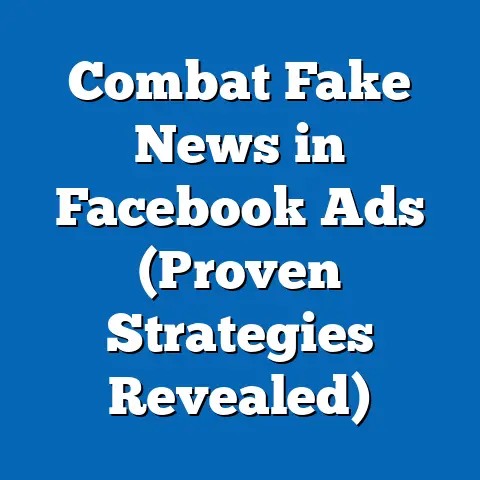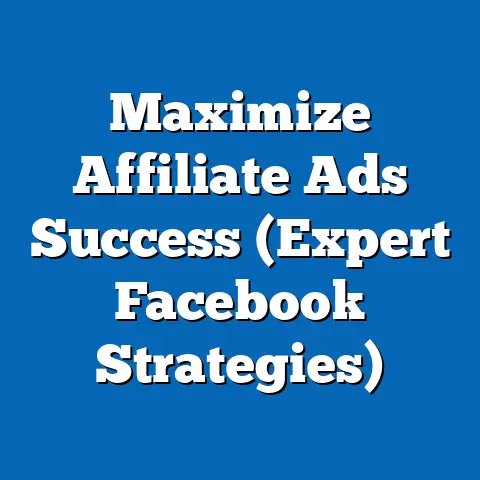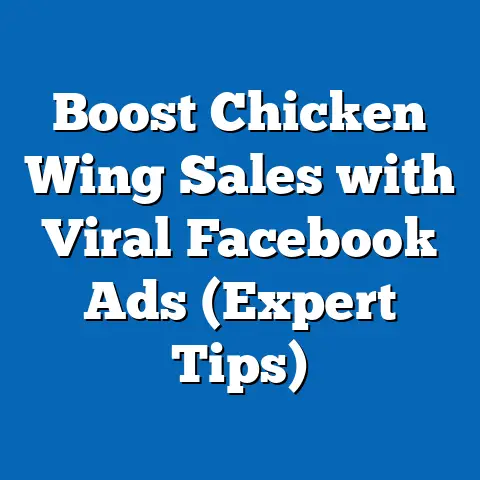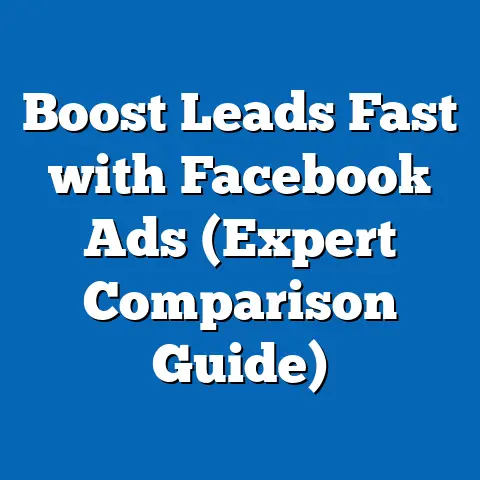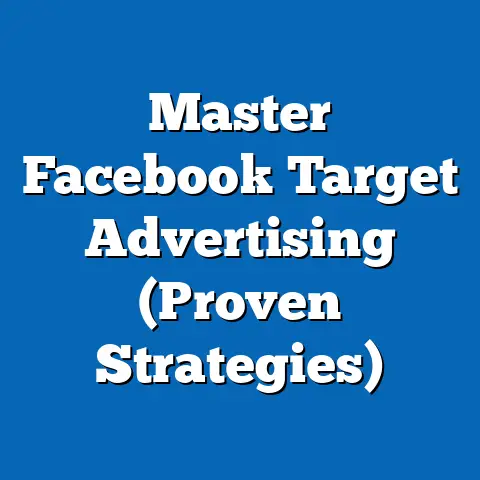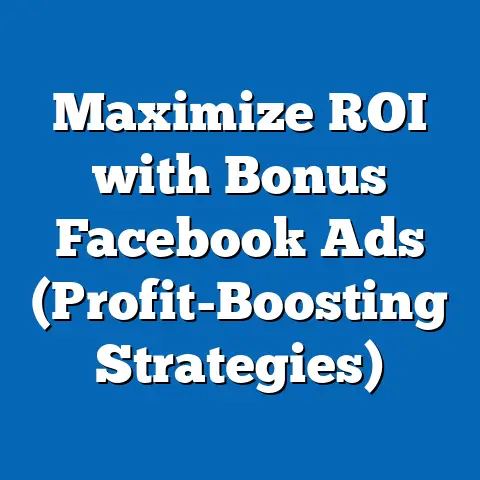Boosting Brand Awareness with Estimated fb ad Recall (Pro Insights)
In today’s digital landscape, brand awareness is more than just getting your name out there; it’s about creating a lasting impression that resonates with your audience. Think of it like this: you want your brand to be the smooth flow of recognition that consumers experience when they instantly connect with your logo, not the rough edges of forgotten campaigns. And in the vibrant colors of effective advertising strategies, Facebook stands out as a powerful canvas. As someone who’s spent years navigating the ins and outs of Facebook advertising, I’ve seen firsthand how the right approach can transform a brand from unknown to unforgettable.
One of the most valuable tools in this transformation? Estimated Facebook Ad Recall. It’s not just another metric; it’s a window into how well your ads are sticking in people’s minds. In this guide, I’ll share pro insights and practical strategies to help you leverage Estimated Ad Recall and create Facebook campaigns that truly boost brand awareness.
Understanding Brand Awareness
Brand awareness is the extent to which consumers are familiar with the distinctive qualities or image of a particular brand. It’s the foundation upon which all successful marketing strategies are built. Without it, your potential customers are less likely to consider your products or services, even if they perfectly meet their needs.
Think of brand awareness as the “warmth” of familiarity a consumer feels when encountering your logo or brand name. It’s the feeling of recognition, of having seen it before, even if they can’t immediately recall the specifics. This feeling can be the difference between a customer choosing your product over a competitor’s.
Brand Recognition vs. Brand Recall
Within brand awareness, there are two key levels:
- Brand Recognition: This is the ability of a consumer to recognize a brand when they see it. For example, if I show you the Nike swoosh, you’ll likely recognize it instantly, even without the word “Nike” present. It’s about visual cues and associations.
- Brand Recall: This is the ability of a consumer to recall a brand from memory when prompted by a category or need. For example, if I ask you to name a sports apparel brand, Nike might be the first one that comes to mind. This is a stronger level of awareness because it means your brand is top-of-mind.
The goal of any brand awareness campaign is to move potential customers from no awareness to recognition, and ultimately to recall. This journey requires consistent messaging, engaging content, and strategic ad placement.
The Role of Facebook Ads in Building Brand Awareness
Facebook, with its billions of active users, offers an unparalleled platform for building brand awareness. It’s a “dynamic environment” where brands can engage with users on a personal level, creating meaningful connections that drive recall and loyalty.
Here’s why Facebook ads are so effective for brand awareness:
- Massive Reach: Facebook boasts a massive user base, allowing you to reach a broad audience or target very specific demographics.
- Granular Targeting: Facebook’s advanced targeting options let you reach users based on interests, behaviors, demographics, and even custom audiences built from your own customer data. I’ve seen campaigns achieve incredible efficiency by leveraging this level of targeting to reach exactly the right people with the right message.
- Engaging Ad Formats: From visually stunning image and video ads to interactive experiences like Instant Experiences, Facebook offers a variety of ad formats to capture attention and drive engagement.
- Cost-Effective: Compared to traditional advertising channels, Facebook ads can be incredibly cost-effective, especially when optimized for reach and frequency.
- Measurable Results: Facebook provides detailed analytics that allow you to track the performance of your campaigns, measure your reach, and understand how users are interacting with your ads.
Did you know? As of 2023, Facebook has nearly 3 billion monthly active users. This represents a significant portion of the global population, making it an indispensable platform for brands looking to expand their reach.
Introduction to Estimated Facebook Ad Recall
Estimated Facebook Ad Recall is a metric that predicts how many people will remember seeing your ad within two days. It’s essentially Facebook’s attempt to quantify the “stickiness” of your ads.
Think of it as the “fluidity” of user engagement, a departure from the “rigidity” of traditional advertising metrics. Unlike impressions or clicks, which simply measure whether an ad was displayed or interacted with, Estimated Ad Recall focuses on whether the ad actually made a lasting impression.
The metric is calculated based on a variety of factors, including:
- Ad Creative: The visual and textual elements of your ad.
- Ad Placement: Where your ad is shown on Facebook (e.g., News Feed, Right Column, Instagram Feed).
- Targeting: The demographics, interests, and behaviors of the audience you’re targeting.
- Frequency: How often people are seeing your ad.
- User Engagement: How people are interacting with your ad (e.g., likes, comments, shares).
Why is Estimated Ad Recall important? Because it provides a more accurate picture of your ad’s effectiveness than traditional metrics. It helps you understand whether your ads are truly resonating with your audience and building brand awareness.
Mechanisms Behind Estimated Ad Recall
The estimation of ad recall on Facebook is a complex process, relying on an “interconnected web” of user behavior, targeting, and ad placements. It’s not just about showing an ad; it’s about making it memorable.
Here’s a breakdown of the key factors that influence Estimated Ad Recall:
- Attention Scores: Facebook uses attention scores to predict how likely a user is to pay attention to an ad. These scores are based on factors like ad format, placement, and user behavior.
- Survey Data: Facebook regularly conducts surveys to ask users about the ads they’ve seen. This data is used to train the algorithms that estimate ad recall.
- Machine Learning: Facebook’s machine learning algorithms analyze vast amounts of data to identify patterns and predict ad recall. These algorithms are constantly learning and improving, making the estimates more accurate over time.
- Brand Lift Studies: These studies measure the impact of your ads on brand awareness, recall, and favorability. The results can be used to refine your targeting and creative strategies.
Understanding these mechanisms allows you to optimize your campaigns for maximum impact. It’s like understanding the “intricate lace” of data analytics that underlies the “solid foundation” of user insights.
Pro Insights on Boosting Estimated Ad Recall
Now, let’s get to the heart of the matter: how to actually boost Estimated Ad Recall in your Facebook campaigns. These are strategies I’ve honed over years of experience, and they’re grounded in real-world results.
-
Craft Compelling Creative: This is the single most important factor. Your ads need to be visually appealing, attention-grabbing, and relevant to your target audience. Think of successful campaigns as having “vibrant textures” and “engaging colors.”
- Use High-Quality Visuals: Invest in professional photography or videography.
- Tell a Story: Connect with your audience on an emotional level.
- Keep it Simple: Avoid clutter and focus on a clear message.
-
Target the Right Audience: Make sure you’re reaching the people who are most likely to be interested in your products or services. Use Facebook’s advanced targeting options to refine your audience.
-
Leverage Lookalike Audiences: Find new customers who are similar to your existing ones.
- Use Custom Audiences: Target people who have already interacted with your brand.
- Test Different Audiences: Experiment with different targeting options to see what works best.
-
Optimize for Frequency: Show your ads frequently enough to make an impression, but not so often that you annoy your audience.
-
Monitor Frequency Metrics: Keep an eye on your frequency scores in Facebook Ads Manager.
- Rotate Your Ads: Prevent ad fatigue by regularly updating your creative.
- Use Frequency Caps: Limit the number of times a user sees your ad.
-
Choose the Right Ad Format: Select the ad format that best suits your message and target audience.
-
Video Ads: Great for storytelling and capturing attention.
- Image Ads: Simple and effective for showcasing products.
- Carousel Ads: Allow you to display multiple images or videos in a single ad.
- Collection Ads: Designed for e-commerce, allowing users to browse and purchase products directly from the ad.
-
A/B Test Everything: Continuously test different elements of your campaigns to see what performs best.
-
Test Different Headlines: See which headlines generate the most clicks and engagement.
- Test Different Visuals: Experiment with different images and videos.
- Test Different Calls to Action: See which calls to action drive the most conversions.
Craft Compelling Creative: This is the single most important factor. Your ads need to be visually appealing, attention-grabbing, and relevant to your target audience. Think of successful campaigns as having “vibrant textures” and “engaging colors.”
- Use High-Quality Visuals: Invest in professional photography or videography.
- Tell a Story: Connect with your audience on an emotional level.
- Keep it Simple: Avoid clutter and focus on a clear message.
-
Target the Right Audience: Make sure you’re reaching the people who are most likely to be interested in your products or services. Use Facebook’s advanced targeting options to refine your audience.
-
Leverage Lookalike Audiences: Find new customers who are similar to your existing ones.
- Use Custom Audiences: Target people who have already interacted with your brand.
- Test Different Audiences: Experiment with different targeting options to see what works best.
-
Optimize for Frequency: Show your ads frequently enough to make an impression, but not so often that you annoy your audience.
-
Monitor Frequency Metrics: Keep an eye on your frequency scores in Facebook Ads Manager.
- Rotate Your Ads: Prevent ad fatigue by regularly updating your creative.
- Use Frequency Caps: Limit the number of times a user sees your ad.
-
Choose the Right Ad Format: Select the ad format that best suits your message and target audience.
-
Video Ads: Great for storytelling and capturing attention.
- Image Ads: Simple and effective for showcasing products.
- Carousel Ads: Allow you to display multiple images or videos in a single ad.
- Collection Ads: Designed for e-commerce, allowing users to browse and purchase products directly from the ad.
-
A/B Test Everything: Continuously test different elements of your campaigns to see what performs best.
-
Test Different Headlines: See which headlines generate the most clicks and engagement.
- Test Different Visuals: Experiment with different images and videos.
- Test Different Calls to Action: See which calls to action drive the most conversions.
Target the Right Audience: Make sure you’re reaching the people who are most likely to be interested in your products or services. Use Facebook’s advanced targeting options to refine your audience.
Leverage Lookalike Audiences: Find new customers who are similar to your existing ones.
Optimize for Frequency: Show your ads frequently enough to make an impression, but not so often that you annoy your audience.
Monitor Frequency Metrics: Keep an eye on your frequency scores in Facebook Ads Manager.
Choose the Right Ad Format: Select the ad format that best suits your message and target audience.
Video Ads: Great for storytelling and capturing attention.
A/B Test Everything: Continuously test different elements of your campaigns to see what performs best.
Test Different Headlines: See which headlines generate the most clicks and engagement.
By implementing these strategies, you can significantly improve your Estimated Ad Recall and create Facebook campaigns that truly build brand awareness.
Analyzing Success Stories
To illustrate the power of Estimated Facebook Ad Recall, let’s look at a couple of success stories. These are “rich narratives” of brands that understood the importance of making a lasting impression.
-
Example 1: A Local Restaurant: A local restaurant wanted to increase brand awareness in its community. They created a series of video ads showcasing their delicious food and inviting atmosphere. They targeted local residents who were interested in food and dining. By optimizing their ads for Estimated Ad Recall, they were able to significantly increase the number of people who remembered seeing their ads. This led to a noticeable increase in foot traffic and sales.
- Key Takeaway: Focus on creating visually appealing ads that showcase your unique offerings.
-
Example 2: An E-Commerce Brand: An e-commerce brand wanted to launch a new product. They created a series of carousel ads highlighting the product’s features and benefits. They targeted potential customers who were interested in the product category. By optimizing their ads for Estimated Ad Recall, they were able to generate significant buzz around the new product and drive sales.
-
Key Takeaway: Use carousel ads to showcase multiple products or features in a single ad.
Example 1: A Local Restaurant: A local restaurant wanted to increase brand awareness in its community. They created a series of video ads showcasing their delicious food and inviting atmosphere. They targeted local residents who were interested in food and dining. By optimizing their ads for Estimated Ad Recall, they were able to significantly increase the number of people who remembered seeing their ads. This led to a noticeable increase in foot traffic and sales.
- Key Takeaway: Focus on creating visually appealing ads that showcase your unique offerings.
-
Example 2: An E-Commerce Brand: An e-commerce brand wanted to launch a new product. They created a series of carousel ads highlighting the product’s features and benefits. They targeted potential customers who were interested in the product category. By optimizing their ads for Estimated Ad Recall, they were able to generate significant buzz around the new product and drive sales.
-
Key Takeaway: Use carousel ads to showcase multiple products or features in a single ad.
Example 2: An E-Commerce Brand: An e-commerce brand wanted to launch a new product. They created a series of carousel ads highlighting the product’s features and benefits. They targeted potential customers who were interested in the product category. By optimizing their ads for Estimated Ad Recall, they were able to generate significant buzz around the new product and drive sales.
Key Takeaway: Use carousel ads to showcase multiple products or features in a single ad.
These examples highlight the “pulse” of successful advertising – the ability to connect with your audience on an emotional level and create a lasting impression.
Measuring and Interpreting Results
Measuring the success of your ad campaigns using Estimated Facebook Ad Recall involves understanding the “nuanced layers” of data. It’s not just about looking at the numbers; it’s about understanding what they mean.
Here are some key metrics to track:
- Estimated Ad Recall Lift (People): This is the estimated number of people who will remember seeing your ad within two days.
- Ad Recall Rate (2-Day): This is the percentage of people who will remember seeing your ad within two days.
- Reach: The number of unique people who saw your ad.
- Frequency: The average number of times each person saw your ad.
- Cost per Estimated Ad Recall Lift: The cost of reaching one person who will remember seeing your ad.
When interpreting these metrics, keep the following in mind:
- Context is Key: Consider the context of your campaign, including your target audience, ad creative, and budget.
- Compare to Benchmarks: Compare your results to industry benchmarks to see how you’re performing relative to your competitors.
- Look for Trends: Identify trends in your data to understand what’s working and what’s not.
- Don’t Overreact: Avoid making drastic changes to your campaigns based on short-term fluctuations in your metrics.
The process of data analysis is like peeling back the layers of an onion to reveal insights. Each layer provides a deeper understanding of your campaign’s performance.
The Future of Brand Awareness on Facebook
The landscape of social media advertising is constantly evolving, with “shifting landscapes” of technology, consumer behavior, and advertising strategies. To stay ahead of the curve, it’s important to anticipate upcoming trends and adapt your strategies accordingly.
Here are some trends to watch:
- The Rise of Video: Video is becoming increasingly dominant on Facebook, and this trend is likely to continue.
- The Importance of Personalization: Consumers are demanding more personalized experiences, and brands need to deliver.
- The Growth of Mobile: Mobile is already the dominant platform for Facebook usage, and this trend is only going to accelerate.
- The Increasing Use of AI: Artificial intelligence is transforming the way we advertise on Facebook, from targeting to creative optimization.
- The Focus on Privacy: Consumers are becoming more concerned about their privacy, and brands need to be transparent about how they’re using their data.
Estimated Facebook Ad Recall will likely evolve as well, becoming more sophisticated and accurate. It may also be integrated with other metrics to provide a more holistic view of campaign performance.
Think of the future as a “fresh canvas” with the “bold strokes” of innovative advertising. By embracing these trends, you can position your brand for success in the ever-changing world of social media marketing.
Conclusion
In conclusion, Estimated Facebook Ad Recall is a powerful tool for boosting brand awareness. By understanding how it works and implementing the strategies outlined in this guide, you can create Facebook campaigns that truly resonate with your audience and drive lasting results.
Remember, brand awareness is more than just getting your name out there; it’s about creating a memorable experience that sticks in people’s minds. By focusing on creating compelling creative, targeting the right audience, optimizing for frequency, and measuring your results, you can achieve “impactful textures” through strategic advertising.
Call to Action
Now it’s your turn. I encourage you to explore your own brand’s potential using the insights shared in this article. Take action, experiment with your Facebook advertising strategies, and see what works best for you.
The world of Facebook advertising is constantly evolving, so it’s important to stay curious, keep learning, and never stop testing. With the right approach, you can transform your brand from unknown to unforgettable. Good luck!

